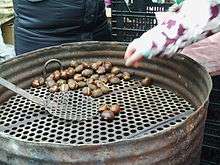Castanyada


The Castanyada (Catalan pronunciation: [kəstəˈɲaðə]) and the Magosto are popular festivals, celebrated in Catalonia and Galicia/ Portugal respectively, mainly on All Saints' Day. In Asturias, it is known as Magüestu and in Portugal as Magusto. In Occitania, the similar festival Castanhada is celebrated, but not on All Saints' Day as in Catalonia.[1] Like Halloween or the Celtic Samhain, its origins are in an ancient ritual festival of the dead.
Catalonia
In Catalonia, celebrations involve eating roast chestnuts, panellets (special biscuits, i.e. cookies), roast or baked sweet potato and preserved fruit (candied or glazed fruit), typically with moscatell to drink. Around the time of this celebration, it is common for street vendors to sell hot toasted chestnuts wrapped in newspaper. In many places, confectioners often organise raffles of chestnuts and preserved fruit.
It seems that the tradition of eating these foods comes from the fact that during All Saints' night, on the eve of All Souls' Day in the Christian tradition, bell ringers would ring bells in commemoration of the dead into the early morning. Friends and relatives would help with this task, and everyone would eat these foods for sustenance.
Other versions of the story state that the Castanyada originates at the end of the 18th century and comes from the old funeral meals, where other foods, such as vegetables and dried fruit were not served. The meal had the symbolic significance of a communion with the souls of the departed: while the chestnuts were roasting, prayers would be said for the person who had just died.[2]
The festival is usually depicted with the figure of a castanyera: an old lady, dressed in peasant's clothing and wearing a headscarf, sitting behind a table, roasting chestnuts for street sale.
In recent years, the Castanyada has become a revetlla of All Saints and is celebrated in the home and community. It is the first of the four main school festivals, alongside Christmas, Carnestoltes and St George's Day, without reference to ritual or commemoration of the dead.[3]
Galicia and Portugal
The "Magosto" or "Magusto" is the essential Galician and Portuguese autumn pagan origin festival similar to the Gaelic Samhain (or "Samaín" word adapted to the Galician from the irish Gaelic). In addition to chestnuts and local young wine, various foods have been incorporated such as sausages and other products made from the pig slaughter, which occurs precisely at that time. Does not usually miss the grilled sardines.
Chestnut festival is traditionally celebrated in the same grove (souto), starting early in the afternoon to collect firewood and chestnuts. One or more bonfires are lit with sticks and pine needles. Young people took to the streets. It was customary for the girls to bring the chestnuts, and for the boys to bring the wine. Chestnuts are roasted on the floor, directly in the fire. Children play to dirt their faces with soot and ash. The adults dance and sing, jumping over the remains of the fire.
References
- ↑ "La castanhada". escomissa.webou.net. Archived from the original on January 20, 2012. Retrieved November 2, 2016.
- ↑ Soler i Amigó, 2001, p. 200.
- ↑ Soler i Amigó, 2001, p. 201.
Sources
- Soler i Amigó, Joan. Cultura popular tradicional. Barcelona:editorial Pòrtic. 2001